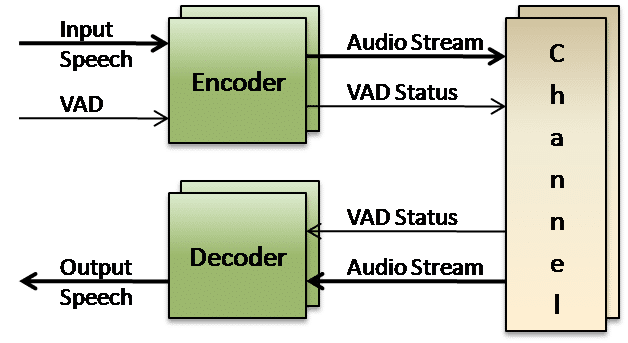
G.729 codec
- Wideband audio codec
- Mobile, VoIP and Voice Conferencing
- Real-time multi-channel implementation
- Optimized for DSPs, RiSC, CISC processors
- ITU-T G.729 compliant
G.729 codec offers high quality, robust speech performance at the price of complexity. Contact us to discuss your G.729 vocoder application requirements.
VOCAL’s G.729 voice compression algorithm is optimized for performance on leading DSPs and RISC/CISC processors from TI, ADI, AMD, ARM, Intel and other vendors. VOCAL offers the G.729 codec as a standalone algorithm, as part of a modular software library suite, as well as with a VoIP stack. Custom designs are also available to meet unique G.729 requirements.
G.729
The G.729 speech coder is an 8 kbps Conjugate-Structure Algebraic-Code-Excited Linear Prediction (CS-ACELP) speech compression algorithm approved by ITU-T. G.729 offers high quality, robust speech performance at the price of complexity. It requires 10 ms input frames and generates frames of 80 bits in length. With the vocoder processing signals in 10 ms frames and a 5 ms look-ahead, the total G.729 algorithmic delay is 15 ms.
Since G.729 is based on the Code-Excited Linear Prediction (CELP) model, each 80 bit frame produced contains linear prediction coefficients, excitation code book indices, and gain parameters that are used by the decoder in order to reproduce speech. The inputs/outputs of the G.729 algorithm are 16 bit linear PCM samples that are converted from/to an 8 kbps compressed data stream.
G.729 Extensions
G.729 is designed and optimized to work in conjunction with Recommendation V.70. However, V.70 mandates the use of G.729 Annex A speech coding methods and, when necessary, the full version of Recommendation G.729 can be used to improve the quality of the speech.
G.729 Annex A specifies a reduced complexity vocoder (G.729A) with several simplifications, involving code book search routines and the decoder postfilter among others. These modifications may result in slightly lower voice quality. G.729 Annex B defines a more efficient vocoder (G.729B) that uses Discontinuous Transmission (DTX), Voice Activity Detection (VAD), and Comfort Noise Generation (CNG) to reduce bandwidth usage by preventing the transmission of any non-voice frames during periods of silence. Note that G.729 Annex D uses 6.4 kbps CS-ACELP compression while G.729 Annex E uses 11.8 kbps CS-ACELP compression.
The line interface may be an analog front end (codec and DAA) or a digital interface such as T1/E1,switched 56 and ISDN. The upper end of this software offers a direct binary and speech frame interface.
Features
- Compliant with G.729, G.729 Annex A, and G.729 Annex B specifications
- Full and half duplex modes of operation
- Passes ITU test vectors
- Optimized for high performance on leading edge DSP architectures
- Multichannel implementation
- Multi-tasking environment compatible
- MISRA compliant version (with limited deviations) available
Configurations
- DAA interface using linear codec at 8.0 kHz sample rate
- Direct interface to 8.0 kHz PCM data stream (A-law or μ-law)
- North American/International Telephony (including caller ID) support available
- Simultaneous DTMF detector operation available – (less than 150 hits on Bellcore test tape typical)
- MF tone detectors, general purpose programmable tone detectors/generators available
- Data/Facsimile/Voice Distinction available
- Common compressed speech frame stream interface to support systems with multiple speech coders
- Dynamic speech coders selection if multiple speech codecs available
- Can be integrated with Acoustic Echo Canceller, G.168 Line Echo Canceller and Tone Detection/Regeneration modules
- Multiple ports can be executed on a single DSP
- Available with VoIP stack
More Information
Platforms
![]()
VOCAL’s optimized vocoder software is available for the following platforms. Please contact us for specific vocoder supported platforms and performance data.
| Processors | Operating Systems |
|---|---|
|
|